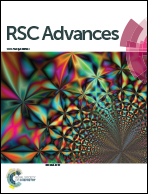Effect of epoxy matrix architecture on the self-healing ability of thermo-reversible interfaces based on Diels–Alder reactions: demonstration on a carbon fiber/epoxy microcomposite
Abstract
Thermally reversible Diels–Alder adducts formed between furan and maleimide groups have been introduced into the interphase of a carbon fiber-reinforced composite material to design a self-healable composite material. The influence of the content of furfuryl glycidyl ether, FGE, comonomer which acts as a furan donor close to the interface was investigated on the architecture and on the thermomechanical properties of an epoxy network by using micro-debonding test. From this method, the debonding force and the fracture energy, Gic, of the interface were determined to analyze the interfacial mechanical properties of these functional composite materials. The suitable content of FGE, i.e. with which the composite system displays not only high interfacial self-healing ability but also keeps significant interfacial mechanical performances, was found to be an inclusion of between 20% and 30% wt.


 Please wait while we load your content...
Please wait while we load your content...